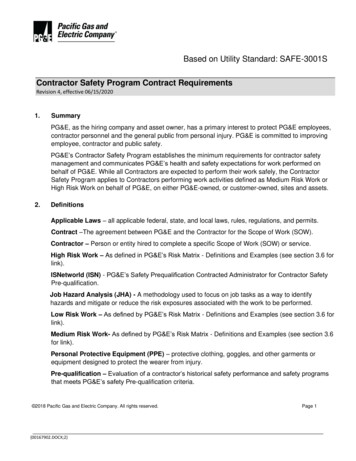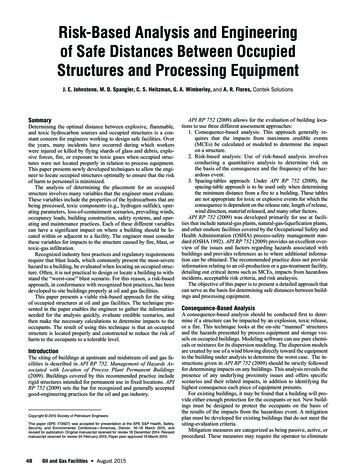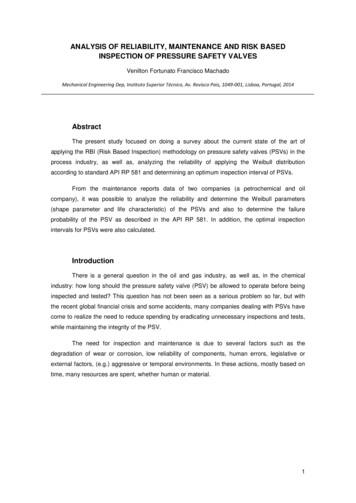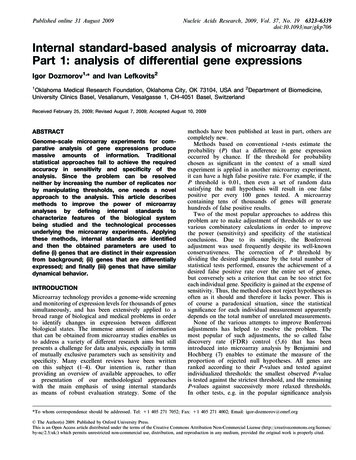
Transcription
Published online 31 August 2009Nucleic Acids Research, 2009, Vol. 37, No. 19 6323–6339doi:10.1093/nar/gkp706Internal standard-based analysis of microarray data.Part 1: analysis of differential gene expressionsIgor Dozmorov1,* and Ivan Lefkovits21Oklahoma Medical Research Foundation, Oklahoma City, OK 73104, USA and 2Department of Biomedicine,University Clinics Basel, Vesalianum, Vesalgasse 1, CH-4051 Basel, SwitzerlandReceived February 25, 2009; Revised August 7, 2009; Accepted August 10, 2009ABSTRACTGenome-scale microarray experiments for comparative analysis of gene expressions producemassive amounts of information. Traditionalstatistical approaches fail to achieve the requiredaccuracy in sensitivity and specificity of theanalysis. Since the problem can be resolvedneither by increasing the number of replicates norby manipulating thresholds, one needs a novelapproach to the analysis. This article describesmethods to improve the power of microarrayanalyses by defining internal standards tocharacterize features of the biological systembeing studied and the technological processesunderlying the microarray experiments. Applyingthese methods, internal standards are identifiedand then the obtained parameters are used todefine (i) genes that are distinct in their expressionfrom background; (ii) genes that are differentiallyexpressed; and finally (iii) genes that have similardynamical behavior.INTRODUCTIONMicroarray technology provides a genome-wide screeningand monitoring of expression levels for thousands of genessimultaneously, and has been extensively applied to abroad range of biological and medical problems in orderto identify changes in expression between differentbiological states. The immense amount of informationthat can be obtained from microarray studies enables usto address a variety of different research aims but stillpresents a challenge for data analysis, especially in termsof mutually exclusive parameters such as sensitivity andspecificity. Many excellent reviews have been writtenon this subject (1–4). Our intention is, rather thanproviding an overview of available approaches, to offera presentation of our methodological approacheswith the main emphasis of using internal standardsas means of robust evaluation strategy. Some of themethods have been published at least in part, others arecompletely new.Methods based on conventional t-tests estimate theprobability (P) that a difference in gene expressionoccurred by chance. If the threshold for probabilitychosen as significant in the context of a small sizedexperiment is applied in another microarray experiment,it can have a high false positive rate. For example, if theP threshold is 0.01, then even a set of random datasatisfying the null hypothesis will result in one falsepositive per every 100 genes tested. A microarraycontaining tens of thousands of genes will generatehundreds of false positive results.Two of the most popular approaches to address thisproblem are to make adjustment of thresholds or to usevarious combinatory calculations in order to improvethe power (sensitivity) and specificity of the statisticalconclusions. Due to its simplicity, the Bonferroniadjustment was used frequently despite its well-knownconservativeness. The correction of P threshold bydividing the desired significance by the total number ofstatistical tests performed, ensures the achievement of adesired false positive rate over the entire set of genes,but conversely sets a criterion that can be too strict foreach individual gene. Specificity is gained at the expense ofsensitivity. Thus, the method does not reject hypotheses asoften as it should and therefore it lacks power. This isof course a paradoxical situation, since the statisticalsignificance for each individual measurement apparentlydepends on the total number of unrelated measurements.None of the various attempts to improve Bonferroniadjustments has helped to resolve the problem. Themost popular of such adjustments, the so called falsediscovery rate (FDR) control (5,6) that has beenintroduced into microarray analysis by Benjamini andHochberg (7) enables to estimate the measure of theproportion of rejected null hypotheses. All genes areranked according to their P-values and tested againstindividualized thresholds: the smallest observed P-valueis tested against the strictest threshold, and the remainingP-values against successively more relaxed thresholds.In other tests, e.g. in the popular significance analysis*To whom correspondence should be addressed. Tel: 1 405 271 7052; Fax: 1 405 271 4002; Email: igor-dozmorov@omrf.orgß The Author(s) 2009. Published by Oxford University Press.This is an Open Access article distributed under the terms of the Creative Commons Attribution Non-Commercial License ) which permits unrestricted non-commercial use, distribution, and reproduction in any medium, provided the original work is properly cited.
6324 Nucleic Acids Research, 2009, Vol. 37, No. 19of microarrays (SAM) method (8,9), the use of individualized thresholds improves the conservativeness of theBonferroni test, though the improvement is only partialand often minor.The relative difference in gene expressions computedfrom replicated hybridizations provides a control forrandom fluctuations, the power of which dependsessentially on the number of replicates. To improvestatistical significance of biological variation withoutincreasing the number of replicates, additional controlsare needed. In the aforementioned methods, like SAM,‘instead of performing more experiments’, which areexpensive and labor intensive, Tusher et al. (8) generateda large number of controls using re-sampling methodssuch as bootstrap or permutation to estimate theunderlying distribution from the observed data.However, generation of larger number of controls byusing combinatory approaches instead of performingmore experiments is somewhat illusory in that it doesnot truly increase the amount of information beinganalyzed.Fortunately, there exists an adequate resource toincrease the power of statistical tests by using themassive quantity of information inherently obtainable ineach microarray experiment. We introduce here anapproach in which the paired comparison of geneexpression in two different situations is accompanied bythe associative test—checking the hypothesis that eachgiven gene in the experimental group has commonfeatures and can be associated with an internal standard.Internal standard in this context is considered as a largefamily of genes sharing some useful features for analysis,which in turn are neither dependent on the particular genesequence nor on the level of expression, and are also notdependent on the coordinate position in the chip.The methodology of the evaluation described in thiscommunication will serve us as a stepping stone to ourfurther effort of using internal standards for analysis ina statistically robust manner, functional associationsthrough clustering and networking genes having similardynamical behavior. These methods are equally applicableto time course dynamics initiated by various treatmentsand to natural variations of genes involved in essentialdynamical processes in biological systems as well.This we intend to describe in the follow-up article(in preparation).Early variants of some procedures described here werefirst included in the Matlab toolbox for microarray dataanalysis MDAT described in Knowlton et al. (10), whilethe improved and modified version exists now and isavailable on request.MATERIALS AND METHODSGene expression datasetsThis work uses a wide spectrum of experimental data thatwere only partially published.The expression datasets were obtained with the usedifferent sources of mRNA and different microarraytechnologies. They include Mouse Atlas 1.2 membranesand Mouse plastic 5K arrays Human Cancer Atlas 1.2membranes (Clontech, Palo Alto, CA). Most data wereobtained with the use of high-density microarrays.Custom microarrays were prepared at the OklahomaMedical Research Foundation Microarray Core Facilityusing commercially available libraries of oligonucleotides:Human Genome Oligo Ser Version 2.0 and mouse genomeset, version 2.0 (Qiagen, Valencia, CA).All data of recent years were obtained with the use ofAffimetrix U133 Plus 2.0 and U95 GeneChips (Human)and Mouse genome 430 2.0 arrays, and the BedArraytechnology—Illumina SentrixÕ Expression BeadChipmicroarrays.Microarray data analysisOur methods of data normalization and analysis are basedon the use of internal standards that characterize someaspects of system behavior such as technical variability.In general, an internal standard is constructed byidentifying a large family of similarly behaving genes.These internal standards are used to estimate in a robustmanner those parameters that describe some state of theexperimental system such as the identification of genesexpressed distinctly from background, differentiallyexpressed genes and genes having similar dynamicalbehavior. This will be elaborated in detail in the Resultssection.Résumé of calculations stepsUpon providing in the Result section, detailed explanations and arguments about the chosen path of calculations, procedures summarizing the calculation steps arepresented in six sequential step-by-step résumés.Step-by-step Résumé 1: individual normalization of themicroarray data to background.Step-by-step Résumé 2: determination of parameters andadjustment of the normalized profiles.Step-by-step Résumé 3: two-sample data adjustment.Step-by-step Résumé 4: multi- sample data adjustment.Step-by-step Résumé 5: reference group of equallyexpressed genes.Step-by-step Résumé 6: gene expression analysis.RESULTSStatistical monitoring of weak spotsAmong the most controversial aspects of the treatmentof data that are related to low-intensity signals, is theprocedure that enables to distinguish between true(specific) hybridization signals and technological noise.In this context, we consider the genes either as ‘expressed’or ‘non-expressed’ though this discrimination is not basedon biological but rather on technological difference.Depending on the sensitivity of the used technology andon technical quality of experiments, the same lowexpression level genes could be treated in high-qualityexperiments as being expressed (distinctively fromnonspecific noise), while in ‘soiled’ experiments (with
Nucleic Acids Research, 2009, Vol. 37, No. 19 6325high level of non-specific hybridizations and/orbackground noise) they would fall in the category ofnon-expressed genes. The importance of discriminationof these genes is related to their different informationcontent for subsequent analytical procedures.Ratio of expressed to non-expressed genes is not ameaningful term. Ratio analysis is commonly employedto determine expression differences between two samples.However, any procedure that uses raw intensities toinfer relative expression is imperfect due to the factthat accuracy is signal-level-dependent, with variationsincreasing dramatically for low intensity signals(9,11,12). Besides, only those ratios that are based onexpressed genes are meaningful. The best demonstrationof this statement could be obtained with array consistingof duplicated spots for each gene (13). Figure 1 presentsresults of such an analysis with the use of data fromClontech membrane array (analogous results wereobtained also with Perkin-Elmer Micromax cDNAarrays of 2400 human genes spotted in duplicates—notshown). The histogram for the distribution of all spotson the array is presented in Figure 1A. Ratios ofduplicated spots that should be equal to 1 with somesystematic variations are depicted in Figure 1B.However, this appeared to be the case only for genesexpressed above certain threshold level (in this particularset, the threshold being 3). Below this threshold, the ratiosare highly variable, demonstrating the absence of anyagreement with the duplicate expressions. It follows thatthe removal of the background level spots should precedeany microarray data analysis based on the use ofexpression ratios.Technologically non-expressed genes represent noncorrelated noise. The distribution of the ratios similar tothat presented in Figure 1B could also be obtained withexpression profiles of samples from a homogenous group,where one expects equal expression of the vast majority ofgenes. Drastically distorted ratios below a certain levelof expression suggest that low levels of gene expressionlack any correlation (Figure 1C). A sharp border thatdiscriminates correlated expressions from non-correlatednoise is obtained when ‘sliding window’ approach forcomparison of the ratio variations (Figure 2) is used. Inthe presented comparison one set is sorted, while keepinggene association with the second set. Thereafter, an F-testis performed for the standard deviation (SD) of ratios ofgenes in the ‘window’ (the 10th lowest one is sample one)compared with the SD of ratios of all remaining geneswith highest expression. When the window moves like astencil along the data stream, one obtains comparativecharacteristics of ratio variability depending uponexpression level. There is a sharp border for the P-value(probability for identity of SD in F-test) in thisdependence as shown in Figure 2B. Above this threshold,there are all possible levels of P-values from 0 to 1 (10sequential genes could have very similar levels ofexpression when the majority of genes in homogenousgroup of samples are equally expressed), however thereare no exclusions for low-expression levels, i.e. allP-values here are close to zero indicating absence of anycorrelation in the noise level expressions. The borderobtained for background noise appears to be in goodagreement with the method for obtaining the zone ofnormally distributed background noise through iterativeprocedure described below.Normally distributed additive noise is a convenient internalstandard for ‘non-expressed genes’. Several meth
Internal standard-based analysis of microarray data. Part 1: analysis of differential gene expressions Igor Dozmorov1,* and Ivan Lefkovits2 1Oklahoma Medical Research Foundation, Oklahoma City, OK 73104, USA and 2Department of Biomedicine, University Clinics Basel, Vesalianum, Vesalgasse 1, CH-4051 Basel, Switzerland

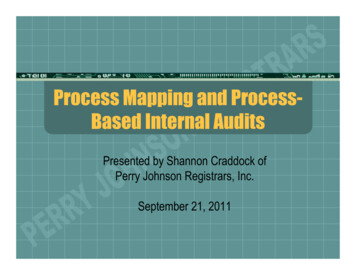
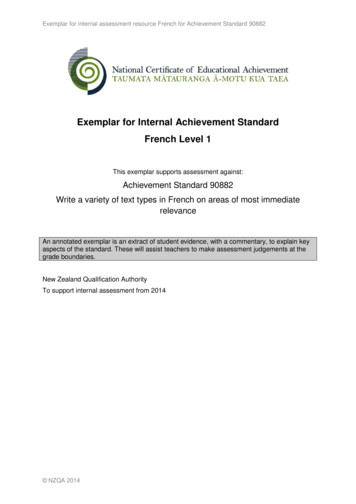

![03[1] Analysis of the Internal Environment](/img/2/031-analysis-of-the-internal-environment.jpg)



